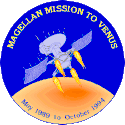Magellan (spacecraft)

Artist's depiction of Magellan at Venus
|
|
| Mission type | Venus orbiter |
|---|---|
| Operator | NASA / JPL |
| COSPAR ID | 1989-033B |
| SATCAT no. | 19969 |
| Website | www2 |
| Mission duration | 4 years, 2 months |
| Spacecraft properties | |
| Manufacturer |
Martin Marietta Hughes Aircraft |
| Launch mass | 3,449 kilograms (7,604 lb) |
| Dry mass | 1,035 kilograms (2,282 lb) |
| Power | about 1,030 watt |
| Start of mission | |
| Launch date | May 4, 1989, 18:47:00 UTC |
| Rocket |
Space Shuttle Atlantis STS-30 / IUS |
| Launch site | Kennedy LC-39B |
| End of mission | |
| Disposal | burned up in the Venusian atmosphere |
| Decay date | October 13, 1994, 10:05:00 UTC |
| Orbital parameters | |
| Reference system | Cytherocentric |
| Semi-major axis | 4,028.5 kilometres (2,503.2 mi) |
| Eccentricity | 0.39177 |
| Pericytherion | 295 kilometres (183 mi) |
| Apocytherion | 7,762 kilometres (4,823 mi) |
| Inclination | 85.5° |
| Period | 3.26 hours |
| Venus orbiter | |
| Orbital insertion | August 10, 1990, 17:00:00 UTC |
 Legacy insignia for the Magellan mission, commemorating the deorbit of the spacecraft in 1994. |
|
The Magellan spacecraft, also referred to as the Venus Radar Mapper, was a 1,035-kilogram (2,282 lb) robotic space probe launched by NASA on May 4, 1989, to map the surface of Venus by using synthetic aperture radar and to measure the planetary gravitational field.
The Magellan probe was the first interplanetary mission to be launched from the Space Shuttle, the first one to use the Inertial Upper Stage booster for launching, and the first spacecraft to test aerobraking as a method for circularizing its orbit. Magellan was the fifth successful NASA mission to Venus, and it ended an eleven-year gap in U.S. interplanetary probe launches.
Beginning in the late 1970s, scientists pushed for a radar mapping mission to Venus. They first sought to construct a spacecraft named the Venus Orbiting Imaging Radar (VOIR), but it became clear that the mission would be beyond the budget constraints during the ensuing years. The VOIR mission was canceled in 1982.
A simplified radar mission proposal was recommended by the Solar System Exploration Committee, and this one was submitted and accepted as the Venus Radar Mapper program in 1983. The proposal included a limited focus and a single primary scientific instrument. In 1985, the mission was renamed Magellan, in honor of the sixteenth-century Portuguese explorer Ferdinand Magellan, known for his exploration, mapping, and circumnavigation of the Earth.
The objectives of the mission included:
The spacecraft was designed and built by the Martin Marietta Company, and the Jet Propulsion Laboratory (JPL) managed the mission for NASA. Elizabeth Beyer served as the program manager and Joseph Boyce served as the lead program scientist for the NASA headquarters. For JPL, Douglas Griffith served as the Magellan project manager and R. Stephen Saunders served as the lead project scientist.
To save costs, most of the Magellan probe was made up of spare parts from various missions, including the Voyager program, Galileo, Ulysses, and Mariner 9. The main body of the spacecraft, a spare one from the Voyager missions, was a 10-sided aluminum bus, containing the computers, data recorders, and other subsystems. The spacecraft measured 6.4 meters tall and 4.6 meters in diameter. Overall, the spacecraft weighed 1,035 kilograms and carried 2,414 kilograms of propellant for a total mass of 3,449 kilograms.
...
Wikipedia
